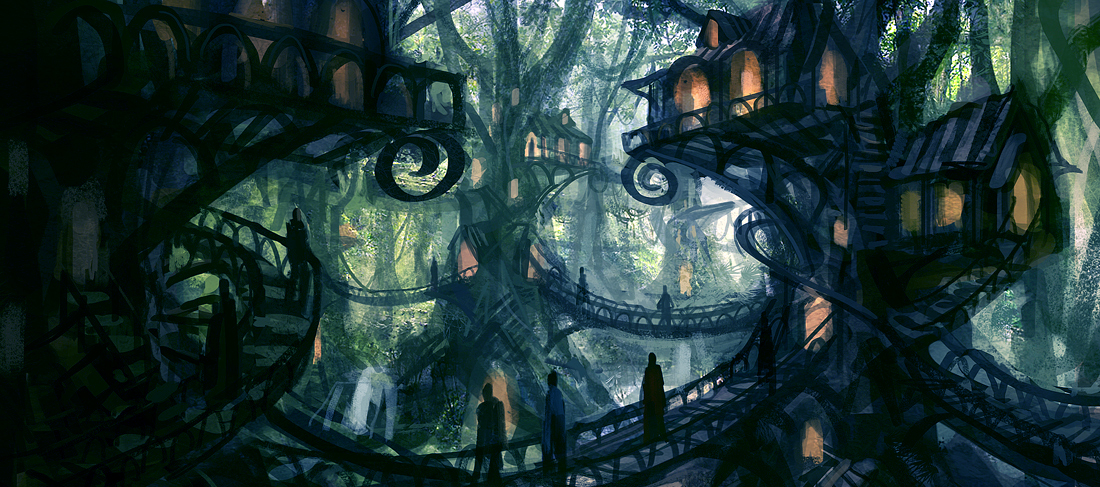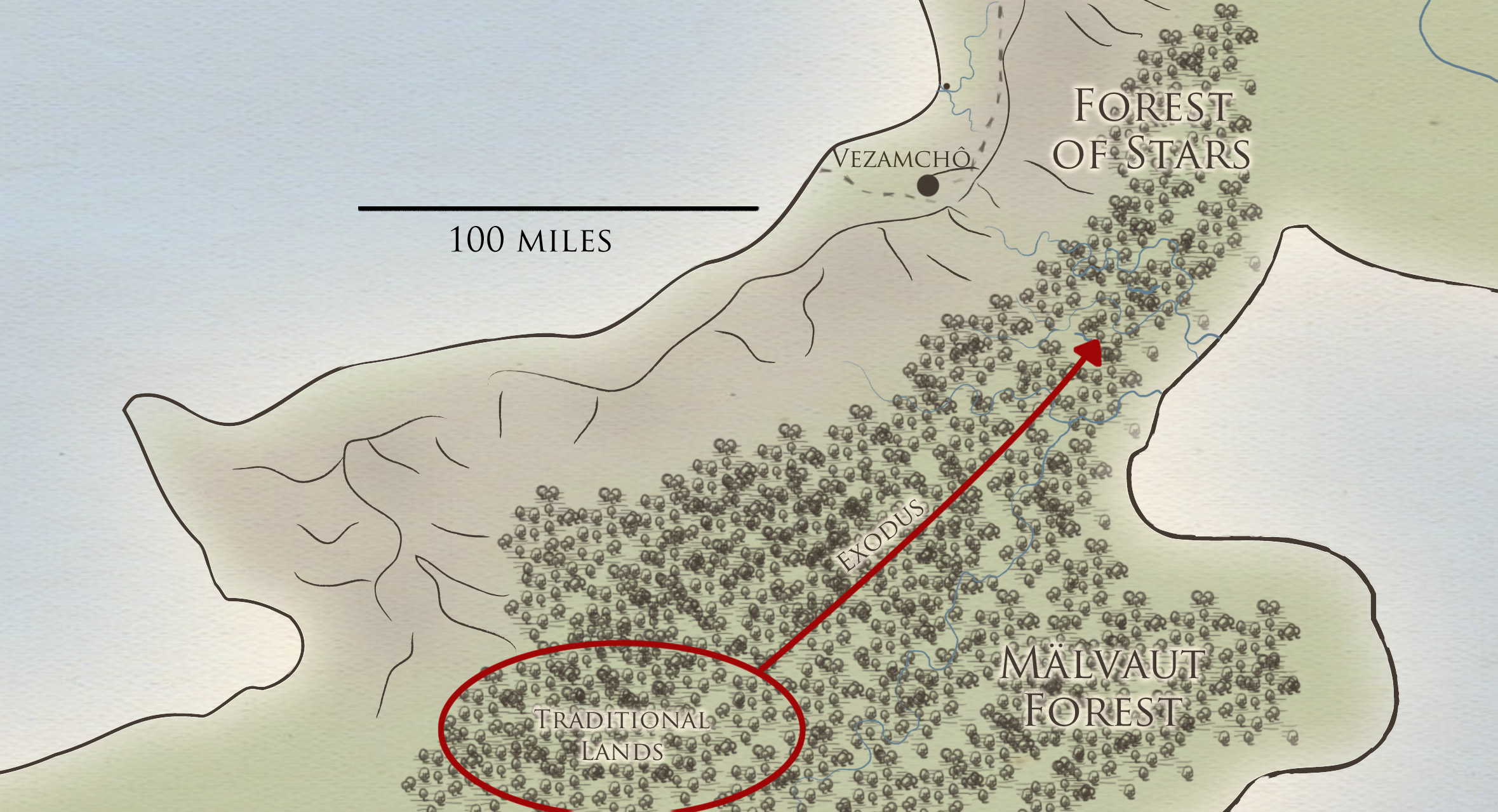Jausai
Jausai is the only major city of the Kivan people, but what a city it is. The city, which means "home" in the local language, is a sprawling collection of districts, parks, rivers, neighbourhoods, and trees.
History
In the time of the Valaran Empire, the Kivan people were farmers and hunters who lived in the southern Mälvaut Forest in scattered villages. They lived there for generations, trading and occasionally warring with other groups in the area.
In the early 2nd century BR, the Valaran Empire began encroaching into Kivan territory. For about 75 years, they managed to remain independent while dealing with the Valaran settlers clearing the woods for livestock. In 124 BR, Valara annexed the land and declared that all Kivans would become citizens of the empire. Though they would receive the full benefits of becoming citizens, it was mandatory that they abandon their pagan beliefs and convert to Adenism.
Area
34,401 km²
Official Language
Kivan
Kivan people were given the choice: convert, or go to exile to the swamp to the north, to the useless land Valara had no interest in. About half of them chose to stay, some converting fully, some continuing to practice their beliefs in secret. The other half began a forced exodus northward, bringing only what they could carry on their back. They travelled a bit over 100 miles to the swamp in the Forest of Stars.
All the regions around the swamp were already occupied by other groups that had no interest in taking in hundreds of refugees, so they were left with the swamp. Not to be discouraged, the 362 families who arrived in the swamp set to work building a settlement there. They build their houses on stilts and in the trees, and worked hard to get as much food from the swamp as they could. They named this new city Jausai and for the next century they managed to turn their swampy rejected land into a sustainable little town.
After The Second Reckoning, the Valaran Empire dissolved. By that time, though, Kivans in Jausai were quite comfortable in their new home. Jausai endured the Reckoning with minimal destruction due to it being so spaced out and low-infrastructure. The homes in the trees were safely above the mass flooding and most of the architecture bent with the trees in the earthquakes rather than breaking. Kivans who had remained in Valara found their homes there in ruins and the populace in chaos, and so immigrated to their cousins in Jausai.
Jausaians welcomed the refugees, both fellow Kivans and other surrounding groups as well. Tauraise, Jennai, and Sarvich refugees all found their way to Jausai in the years following the Reckoning. Although many of them returned to their homelands after the world stabilized, many others remained in Jausai and the city now hosts several distinct minority neighbourhoods.
Demographics
Jausai is a diverse city. About 75% of the population are ethnically Kivan. About a quarter of those are Adenist Kivans who immigrated after the Reckoning, after their families had converted generations earlier in Valara. The other 25% is made up of other groups from the surrounding area, most of whose ancestors came to Jausai in the years following the Reckoning and never left. This includes Valarans, Jennai, Sarvichs, and Tauraise, as well as small numbers of miscellaneous groups.
The different groups get along reasonably well, though there is some tension. The city is governed by the Oväs, which is made up of the descendants of the original 362 families. The ideal is that these representatives cast votes on behalf of their families, but after the influx of immigrants after the Reckoning, a good 40% of the population is not descended from those families. This has created a pseudo-noble class that often looks down upon the "foreigners" (even if said foreigners have been in Jausai for 300 years).
Although there is no official segregation, many ethnic groups are divided into their own neighbourhoods. Given how spread out Jausai is, a neighbourhood may as well be a self-contained village in some respects. Unfortunatly, this division makes it even less likely for groups to intermarry, which is the only way for these non-original families to inherit a position in the Oväs.
Government
The city is led by the Speaker, who is elected by the Oväs. The Oväs also serves as city council, and votes on laws. The Speaker does not need to be a member of the Oväs, but usually is, considering only the Oväs has a vote and they vote for their own.
On equal status with the Speaker is the Singer, the shaman. The Singer is the leader of spirituality and religion among the Kivan people. He or she is not elected, but individually chosen by the current Singer from notable lesser shamans in the forest.
Defences
The city doesn't have much in the way of constructed defences. They rely on their position in the swamp and if invaders ever came, they would be able to pull up their ladders and stairs and stay safe in their tree houses.
Industry & Trade
Jausai is positioned in the opportune place to take advantage of cross-continental trade. Their position at the pass through the Shiver Mountains allows them to extract taxes on all merchandise passing between the easy and the west, making the city wealthy. The constant stream of travellers supports inns and shops as well. This keeps them going, because they have very little natural resources given the swampy terrain. They import a lot of food from drier areas and their main export is wood carvings. Jausaian carpenters are famous for their furniture and wooden sculptures, which they happily sell to traders passing through.
Infrastructure
Away from the main surge of river, the swamp below the buildings is put to use. Some sections are fenced in to grow water plants or farm fish, while other sections have been built up with mud, vegetation, and soil to create "floating gardens".
Architecture
The locals took cues from the Weaver Bats and built their homes elevated from the water, with a mixture of stilt and tree houses - often mixed within the same building. One of the guiding tenets of Jausaian architecture is to build *around* nature, rather than cut or move it. It's common to see houses with branches sticking through the roof or for one wall of a stilt house to be the thick trunk of a tree it's pressed against.
The primary construction material is wood, which they have in great supply. Hardly any precipitation makes it past the canopy, so most people have fairly shallow slopes to the roof, or else leave them flat as part of the walkway above them. They prefer round, curving patterns with few straight edges. Many decorations are patterned around spirals or leaves.
Boardwalks encircling trees or connecting short distances are usually made wholly out of wood, but longer bridges are made from rope or twisted vines. There are some places where the bridge is just three ropes strung between two trees, though most crossings have wooden planks.
In the autumn and winter, Starfly cocoons are collected and placed in lanterns and then hung from railings and rafters. Below the buildings is a network of boardwalks and staircases. In the winter, the swamp freezes. Weaver nets and buildings overhead mean hardly any snow reaches the ground, so the clear ice becomes a useful surface for markets, skating, or just walking around.
In the autumn and winter, Starfly cocoons are collected and placed in lanterns and then hung from railings and rafters. Below the buildings is a network of boardwalks and staircases. In the winter, the swamp freezes. Weaver nets and buildings overhead mean hardly any snow reaches the ground, so the clear ice becomes a useful surface for markets, skating, or just walking around.
Geography
The city is located between the Meena and Vaïlva rivers within the swampiest section of the Forest of Stars. Water from the quicker-moving currents in the rivers is fresh enough to drink.
Cover image:
Tree Village
by
E Mendoza



